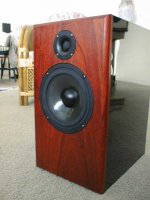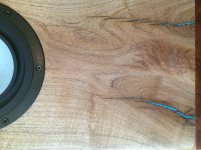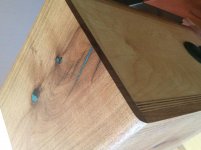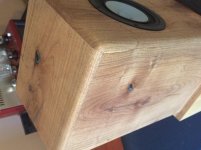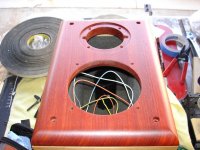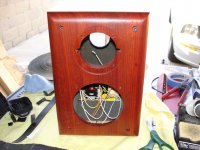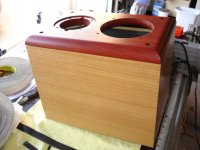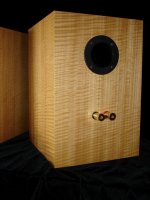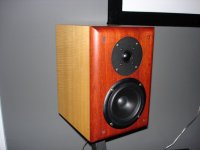Back in the early 90s I built a pair of quarter wavelength TL bookshelf speakers. Used 8” x 14.5” x 1.25” solid walnut (flat sawn) for the baffle in an otherwise all-plywood cabinet. The baffle is recessed 1/4” into the plywood. No screws were used except for the drivers and crossover mounting. I still have them and they are rock solid.
Lovely work Kec!
Regarding glues....
Some years ago there was an article in speaker builder magazine regarding glues for loudspeaker construction. The authors of the article tried a few different glues and found that Aerolite Evostick provided a superior bond and superior sound quality too. The author did what appeared to be a good test and the majority of listeners found the Aerolite glued cabinet superior - audibly !
I think the Aerolite glue was 306, but my memory is foggy. I did purchase some of the glue from Aircraft Spruce and tried it. It came in powder form and needed to be mixed with water. I... don't recall a hardener, but I could be wrong. The glue was a urea-formaldehyde resin for spruce aircraft and was certified at some time.
So, I built a good set of a/b test cabinets for myself. One pair of cabinets was Titebond type 1. The other pair was glued with Aerolite. I couldn't hear any difference. And, my wife and friends also couldn't hear any difference.
There are obviously a bunch of variables that changed between my test and the speaker builder test. Maybe my MDF glue surface was greater. Maybe my bracing was better. Maybe the magazine guys used solid wood bracing and plywood (I don't recall).
In any event, for me and my MDF core cabinets, Titebond 1 would be the glue of choice. It cleans up nicely after being stuck to clothes in the workshop. And, it sounded plenty good in testing.🙂
I do like the darker color of Titebond 3, but it doesn't wash out of my clothes in the washing machine.🙁
I have never tried to glue an oily lumber like teak.
I did try to glue white oak to treated plywood on 1 occasion - using Gorilla glue - the kind that foams with water. The glue joint gap was really sloppy. Initially the glue expansion & fill looked perfect, but after a couple days the glue literally turned to dust and fell apart.😱
Regarding glues....
Some years ago there was an article in speaker builder magazine regarding glues for loudspeaker construction. The authors of the article tried a few different glues and found that Aerolite Evostick provided a superior bond and superior sound quality too. The author did what appeared to be a good test and the majority of listeners found the Aerolite glued cabinet superior - audibly !
I think the Aerolite glue was 306, but my memory is foggy. I did purchase some of the glue from Aircraft Spruce and tried it. It came in powder form and needed to be mixed with water. I... don't recall a hardener, but I could be wrong. The glue was a urea-formaldehyde resin for spruce aircraft and was certified at some time.
So, I built a good set of a/b test cabinets for myself. One pair of cabinets was Titebond type 1. The other pair was glued with Aerolite. I couldn't hear any difference. And, my wife and friends also couldn't hear any difference.
There are obviously a bunch of variables that changed between my test and the speaker builder test. Maybe my MDF glue surface was greater. Maybe my bracing was better. Maybe the magazine guys used solid wood bracing and plywood (I don't recall).
In any event, for me and my MDF core cabinets, Titebond 1 would be the glue of choice. It cleans up nicely after being stuck to clothes in the workshop. And, it sounded plenty good in testing.🙂
I do like the darker color of Titebond 3, but it doesn't wash out of my clothes in the washing machine.🙁
I have never tried to glue an oily lumber like teak.
I did try to glue white oak to treated plywood on 1 occasion - using Gorilla glue - the kind that foams with water. The glue joint gap was really sloppy. Initially the glue expansion & fill looked perfect, but after a couple days the glue literally turned to dust and fell apart.😱
I guess we can all agree that solid wood moves with the change in moisture content. This movement can widely vary depending on many factors including species,cut,and fluctuations in humidity do to regions around the planet. That being said gluing 2 objects together that are not compatible will cause stress on the joint enough that in time(5,10,25years)something has got to give. This may not be obvious on the surface particularly when the assembly is done in a way to hide the flush smoothness of the joint. The slight overhang of the front or small v groove between the mating surfaces are much less obviously than a smooth continuous surface.
I have no input regarding the use of epoxy in place of wood glue nor would I personally glue a solid wood baffle to the front of a ply box but using the stables quarter sawn piece that has been acclimated to its future location will give you the best chance of success.
I have no input regarding the use of epoxy in place of wood glue nor would I personally glue a solid wood baffle to the front of a ply box but using the stables quarter sawn piece that has been acclimated to its future location will give you the best chance of success.
Ellis when I build something I like to use tried& proven methods that will maximize the life expectancy of the piece. If the wood is not happy and under stress it will eventually self distruct.
Last edited:
I used regular Titebond wood glue to glue 3/8" mesquite panels to proper plywood bookshelf kit (MA A10p) from Brines Acoustics many years ago and have had no problems with it. I did use epoxy though to seal crushed turquoise into the mesquite's cracks.
Attachments
Terrific Cabinet work! Veneer can look decent, but there is most often something better and more authentic in the appearance of solid lumber.
Hmmm...
Well, first off, thanks to all that responded to my post. I do not want the front panels to crack, that is for sure. I have never used veneer, although I have a small amount of a really bland looking species somewhere. I am confident that I would not do a good enough job on my first attempt to be able to use veneer... That leaves me with a Baltic Birch front panel...Maybe I can inset two narrow solid hardwood strips into either side for some visual interest and leave it at that.
Thanks again! I am grateful for all the advice.
Joe H.
Well, first off, thanks to all that responded to my post. I do not want the front panels to crack, that is for sure. I have never used veneer, although I have a small amount of a really bland looking species somewhere. I am confident that I would not do a good enough job on my first attempt to be able to use veneer... That leaves me with a Baltic Birch front panel...Maybe I can inset two narrow solid hardwood strips into either side for some visual interest and leave it at that.
Thanks again! I am grateful for all the advice.
Joe H.
Hi quality Baltic birch is very nice looking and I’ve left many a cabinet un veneered and it’s beautiful ... just be careful and don’t sand too much as you don’t want to expose that next deeper level of ply. I’ve tried to stain the BB once or twice but it turned out blotchy...the best finish on a plain BB baffle for me has been easy wipe on polyurethane or a poly/oil mix like Emmet’s Good Stuff... have fun!
That being said gluing 2 objects together that are not compatible will cause stress on the joint enough that in time(5,10,25years)something has got to give.
Are you conveying that in ALL circumstances that a glue-joint connecting solid cross-grain lumber to solid long-grain lumber will fail in 5, 10, 25 years ?
Or, perhaps you mean something else by not compatible ?
Might you explain your statement ?
Joe not all quartered/rift cuts are boring.
Lee Valley sells a "wood movement reference chart" for some 50 or so species a little calculation will give you expected movement for flat sawn and quartered cuts to help pick a piece.
Paduak with sun exposure will not maintain its brilliant color but turn a brownish red which is not as attractive.
There are more ways to construct a box depending on you equipment and experience
Lee Valley sells a "wood movement reference chart" for some 50 or so species a little calculation will give you expected movement for flat sawn and quartered cuts to help pick a piece.
Paduak with sun exposure will not maintain its brilliant color but turn a brownish red which is not as attractive.
There are more ways to construct a box depending on you equipment and experience
Ellis no I am not but we have to consider a small amount of elasticity in wood glue to allow minimal movement, the longer the joint the more stress. A quality build piece is still a teenager at 25.
There is no black and white but a little gray. A 2" wide tenon or bridal joint properly fitted should grow old gracefully even draw bored for extra longevity.
There is no black and white but a little gray. A 2" wide tenon or bridal joint properly fitted should grow old gracefully even draw bored for extra longevity.
Last edited:
You are correct the joint will be under continuous stress because of the ebb&flow movement of solid wood. This will eventually cause the joint to self distruct.
a small amount of elasticity in wood glue to allow minimal movement, the longer the joint the more stress.
Your first assertion was emphatic and absolute. Your second assertion conveys glue elasticity holding lumber during movement.
Can you explain ?
Maybe your initial thoughts were incomplete ?
Paduak with sun exposure will not maintain its brilliant color but turn a brownish red which is not as attractive.
Also, if you use some oil finishes you may get a brownish red color. One of my favorite finishes is Watco Natural oil followed by a paste wax (Minwax). But, since i knew this would turn the beautiful Paduak into an ugly color, I used a clear laquer finish instead - pictured in a previous post.
For woods that change drastically with sun exposure like padauk, purpleheart, redheart, there’s a simple trick to keep the color. Apply a high SPF sunscreen to the wood, let it absorb, then apply your finish of choice. It works under oil, lacquer, and acrylic topcoats.
For woods that change drastically with sun exposure like padauk, purpleheart, redheart, there’s a simple trick to keep the color. Apply a high SPF sunscreen to the wood, let it absorb, then apply your finish of choice. It works under oil, lacquer, and acrylic topcoats.
Yes, Yes Yes. Me Too! This was and generally still IS an almost idiot-proof way to get a great looking finish on lumber. I have sprayed and rubbed thick lacquer, but Watco is soooo much easier!
My only recommendation herein is to ensure the Watco will setup before use on actual lumber. This can be accomplished by wetting a paper towel and allowing it to fully air-dry ( do NOT enclose a watco-soaked paper towel in an air tight environment ).
The only problem I have experience with Watco is failure to setup & harden. About 20 years ago I wiped watco with steel wool and removed the excess after 15-20 minutes, then waited a day, 2 days, 3 days, then a week for the Linseed oil smell to dissipate. I might have waited 2 weeks, and the smell still was not gone. I eventually had to dissolve the watco and re-start the finishing process. This consumed about a month.
At the 3 day point I decided to wet a paper towel with the same Watco and leave the towel in the open air to dry. If the towel stiffened = GREAT ! I didn't stiffen. At this point, I knew the Watco was bad. This Watco was from a fresh/new 1 gallon container, and it just didn't harden. I added about 2 tbsp of Japan Drier to the gallon of watco - fixed !
I think Bob Flexner commented that Boiled Linseed oil really hasn't been boiled. Boiled Linseed oil is simply Linseed oil with Japan Drier added. Adding Japan Drier is necessary for Linseed oil hardening.
After this gallon, I started mixing my own Watco and I have been doing this for years. I prefer Naptha for the solvent and use a method similar to this: Make Your Own Oil/Varnish Blend - The Wood Whisperer .
I always test for hardening using a soaked paper towel then add some Japan drier if necessary.
Last edited:
I blend my own finishes a lot, I don't believe every piece needs the protection of a hard varnish or lacquer. I also modify the mixture on the last coat or two, add varnish less oil or add some beeswax to a oil blend.
Building a hard shell surface I reserve for tabletops etc.
Building a hard shell surface I reserve for tabletops etc.
Here's some pics of the Swifty I built years ago using Padauk. The box is anigre veneer on the box (MDF). Finish is all Deft satin lacquer (spray cans).
You might be saying to yourself, why does this guy use Padauk so much? Well, I bought 10" x 3/4" x 8' piece at Rockler a long time ago 😀
You might be saying to yourself, why does this guy use Padauk so much? Well, I bought 10" x 3/4" x 8' piece at Rockler a long time ago 😀
Attachments
Your first assertion was emphatic and absolute. Your second assertion conveys glue elasticity holding lumber during movement.
Can you explain ?
Maybe your initial thoughts were incomplete ?
In general, when someone makes a strongly worded statement, it's not absolute but something that *needs* to be well though out. So a solid wood baffle in southern California, where moisture content remains in a very tight band is going to behave wildly different to you in MN or Paul in Canada.
Similarly, narrow baffles are going to have fewer problems than wide ones. But there's enough tables and furniture out there that have self-destructed by ignoring expansion contraction forces. So it's not something that should be casually ignored.
- Home
- Loudspeakers
- Full Range
- Solid hardwood front panel ok?
